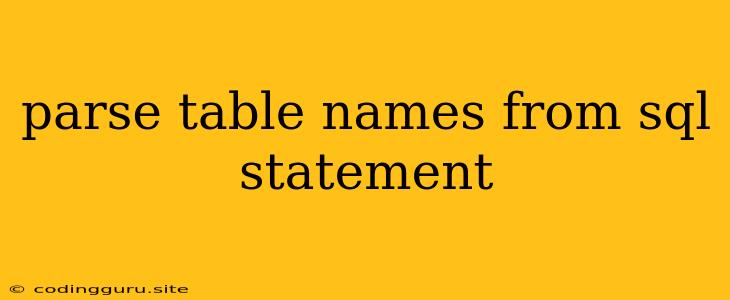Extracting Table Names from SQL Statements: A Guide
Extracting table names from SQL statements is a common requirement in various applications, including database management tools, code analysis software, and query optimizers. This process, often referred to as SQL parsing, involves analyzing the structure of the SQL statement to identify the tables involved. While seemingly simple, this task can be complex due to the variety of SQL syntax and the presence of nested queries, subqueries, and complex joins.
Understanding the Challenge
The challenge lies in the diverse nature of SQL statements. You might encounter simple SELECT statements, intricate JOIN queries, and even complex statements with nested subqueries. Each statement requires a different approach to accurately extract the table names.
For instance:
Simple SELECT statement:
SELECT * FROM users;
In this case, identifying the table name is straightforward – users.
Complex JOIN statement:
SELECT orders.order_id, customers.name
FROM orders
JOIN customers ON orders.customer_id = customers.id;
Here, we need to extract two table names: orders and customers.
Nested SELECT statement:
SELECT * FROM products
WHERE product_id IN (SELECT product_id FROM orders);
In this scenario, you need to identify both the outer table (products) and the inner table (orders) within the subquery.
Approaches to Extract Table Names
Several approaches can be used to extract table names from SQL statements. Let's explore some of them:
1. Regular Expressions
Regular expressions can be a simple and effective way to identify table names, especially for simpler SQL statements. However, crafting a comprehensive regular expression that accounts for all possible SQL syntax variations can be a challenging task.
Example:
import re
sql_statement = "SELECT * FROM users WHERE age > 25;"
table_names = re.findall(r"FROM\s+(\w+)", sql_statement)
print(table_names) # Output: ['users']
This code utilizes a regular expression to find the table name after the FROM keyword. While this works for basic cases, it might fail for more complex scenarios.
2. Parsing Libraries
Using dedicated parsing libraries is often the most reliable and efficient approach. These libraries, designed specifically for parsing SQL statements, offer comprehensive support for various SQL syntax variations, including complex statements with joins and subqueries.
Example using sqlparse library in Python:
import sqlparse
sql_statement = "SELECT * FROM orders JOIN customers ON orders.customer_id = customers.id;"
parsed_statement = sqlparse.parse(sql_statement)[0]
table_names = []
for token in parsed_statement.tokens:
if token.ttype == sqlparse.tokens.Name:
table_names.append(token.value)
print(table_names) # Output: ['orders', 'customers']
This code leverages the sqlparse library to parse the SQL statement and then iterates through the tokens to identify those representing table names.
3. Tokenization and Grammar Analysis
This approach involves breaking down the SQL statement into individual tokens, such as keywords, identifiers, and operators. Then, you analyze the tokens based on the SQL grammar to identify table names.
Example using a custom grammar in Python:
from lark import Lark
sql_grammar = """
start: select_statement
select_statement: "SELECT" select_list "FROM" table_name
select_list: "*" | identifier ("," identifier)*
table_name: identifier
identifier: /[a-zA-Z_][a-zA-Z0-9_]*/
"""
parser = Lark(sql_grammar)
sql_statement = "SELECT * FROM users;"
parse_tree = parser.parse(sql_statement)
table_name = parse_tree.find_data("table_name")[0].children[0]
print(table_name) # Output: 'users'
This code defines a grammar for the SQL syntax and then uses the lark library to parse the SQL statement. The parsed tree is then traversed to extract the table name.
Tips for Robust Table Name Extraction
Here are some tips to ensure robust table name extraction:
- Handle Case Sensitivity: Different databases handle case sensitivity differently. Ensure your solution accounts for this.
- Consider Aliases: Pay attention to table aliases used in the SQL statement.
- Deal with Nested Queries: Implement logic to extract table names from nested subqueries.
- Handle Special Characters: Be aware of special characters used in table names and handle them accordingly.
Conclusion
Extracting table names from SQL statements requires careful consideration of the SQL syntax variations and complexities. While regular expressions offer a quick solution for simple statements, utilizing parsing libraries or implementing custom grammar analysis ensures more comprehensive and robust parsing. By leveraging these techniques and following the tips outlined above, you can successfully identify and extract table names from SQL statements, enabling various applications and tools to process and analyze SQL data effectively.
